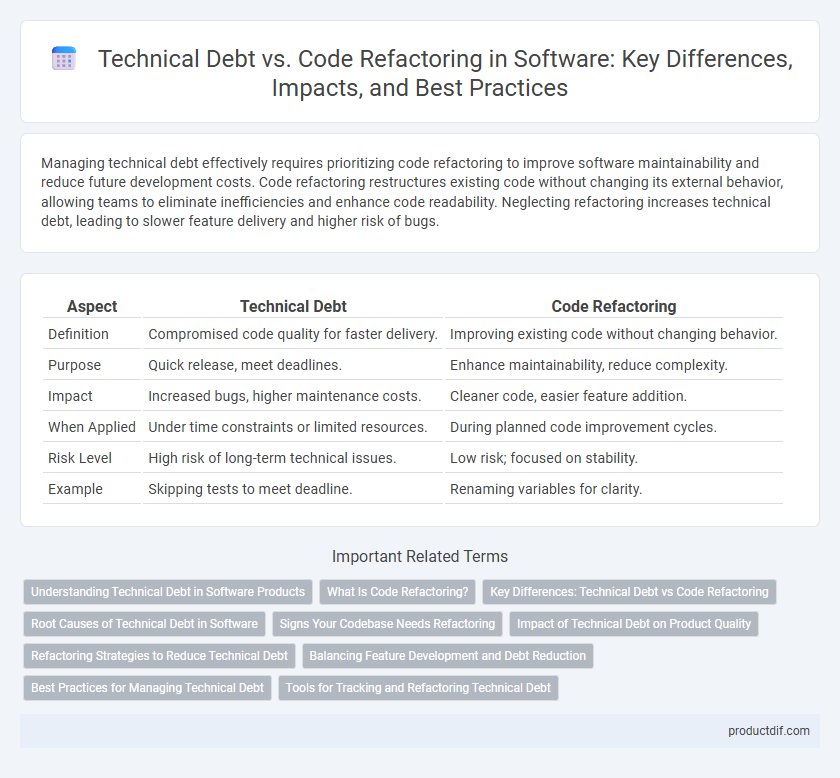Managing technical debt effectively requires prioritizing code refactoring to improve software maintainability and reduce future development costs. Code refactoring restructures existing code without changing its external behavior, allowing teams to eliminate inefficiencies and enhance code readability. Neglecting refactoring increases technical debt, leading to slower feature delivery and higher risk of bugs.
Table of Comparison
| Aspect | Technical Debt | Code Refactoring |
|---|---|---|
| Definition | Compromised code quality for faster delivery. | Improving existing code without changing behavior. |
| Purpose | Quick release, meet deadlines. | Enhance maintainability, reduce complexity. |
| Impact | Increased bugs, higher maintenance costs. | Cleaner code, easier feature addition. |
| When Applied | Under time constraints or limited resources. | During planned code improvement cycles. |
| Risk Level | High risk of long-term technical issues. | Low risk; focused on stability. |
| Example | Skipping tests to meet deadline. | Renaming variables for clarity. |
Understanding Technical Debt in Software Products
Technical debt in software products refers to the accumulation of suboptimal code and design decisions made to expedite delivery but resulting in increased future maintenance costs and reduced code quality. It arises from shortcuts, insufficient testing, or inadequate documentation, leading to bugs, slower feature development, and system instability. Understanding technical debt helps prioritize refactoring efforts, improve code maintainability, and enhance overall product performance by systematically addressing underlying code issues.
What Is Code Refactoring?
Code refactoring is the process of restructuring existing computer code without changing its external behavior to improve its readability, maintainability, and performance. It involves techniques such as renaming variables, breaking down complex functions, and eliminating redundant code, which collectively reduce technical debt. Effective refactoring enhances code quality, facilitates easier debugging, and streamlines future software development efforts.
Key Differences: Technical Debt vs Code Refactoring
Technical debt refers to the accumulation of suboptimal code shortcuts and quick fixes that hinder future development and increase maintenance costs, whereas code refactoring involves systematically improving existing code structure without changing its external behavior to enhance readability and reduce complexity. Technical debt often results from prioritizing speed over code quality during development, leading to decreased system performance and increased risk of bugs. Code refactoring is a proactive practice aimed at addressing these issues by optimizing code maintainability and facilitating long-term project scalability.
Root Causes of Technical Debt in Software
Technical debt in software primarily stems from rushed development, insufficient testing, and lack of clear documentation, leading to fragile and hard-to-maintain codebases. Poor architectural decisions and legacy system dependencies exacerbate complexity, increasing maintenance costs and reducing agility. Code refactoring systematically addresses these issues by improving code structure without changing its external behavior, thereby reducing technical debt over time.
Signs Your Codebase Needs Refactoring
Frequent bugs, slow feature delivery, and complex code structures signal escalating technical debt requiring immediate refactoring. Codebases exhibiting duplicated logic, poor test coverage, and confusing dependencies hinder maintainability and scalability. Refactoring improves code clarity, reduces complexity, and enhances system performance, directly addressing technical debt challenges.
Impact of Technical Debt on Product Quality
Technical debt significantly degrades product quality by introducing defects, reducing code maintainability, and increasing the complexity of future enhancements. Accumulated technical debt often leads to slower development cycles and higher bug rates, undermining user experience and system reliability. Continuous code refactoring helps mitigate this impact by improving code structure, facilitating easier debugging, and enhancing overall software performance.
Refactoring Strategies to Reduce Technical Debt
Effective refactoring strategies to reduce technical debt include implementing incremental code improvements, prioritizing critical modules for refactoring, and automating code quality checks using static analysis tools. Emphasizing modular design and continuous integration enhances maintainability while minimizing the accumulation of new technical debt. Incorporating comprehensive code reviews and test-driven development further ensures codebase integrity and accelerates debt resolution.
Balancing Feature Development and Debt Reduction
Balancing feature development and technical debt reduction is essential for maintaining long-term software quality and agility. Prioritizing code refactoring in development cycles minimizes accumulated debt that can degrade system performance and increase maintenance costs. Integrating refactoring tasks with feature implementation ensures continuous improvement while delivering new functionalities efficiently.
Best Practices for Managing Technical Debt
Managing technical debt effectively involves prioritizing regular code refactoring to improve code quality and maintainability while preventing accumulation of outdated or inefficient code structures. Implementing automated code analysis tools helps identify complex or redundant sections that require refactoring, enabling teams to allocate resources strategically and minimize long-term costs. Establishing clear guidelines for documenting and reviewing technical debt ensures transparency and promotes a proactive approach to continuous improvement in software development workflows.
Tools for Tracking and Refactoring Technical Debt
Effective management of technical debt relies on specialized tools like SonarQube, which provides continuous code quality analysis and detects code smells, bugs, and vulnerabilities. Refactoring tools such as JetBrains ReSharper and Visual Studio Code extensions streamline the code improvement process by automating common refactoring tasks while maintaining code integrity. Integration of these tools into CI/CD pipelines ensures ongoing tracking and resolution of technical debt, enhancing software maintainability and reducing long-term costs.
Technical Debt vs Code Refactoring Infographic

 productdif.com
productdif.com